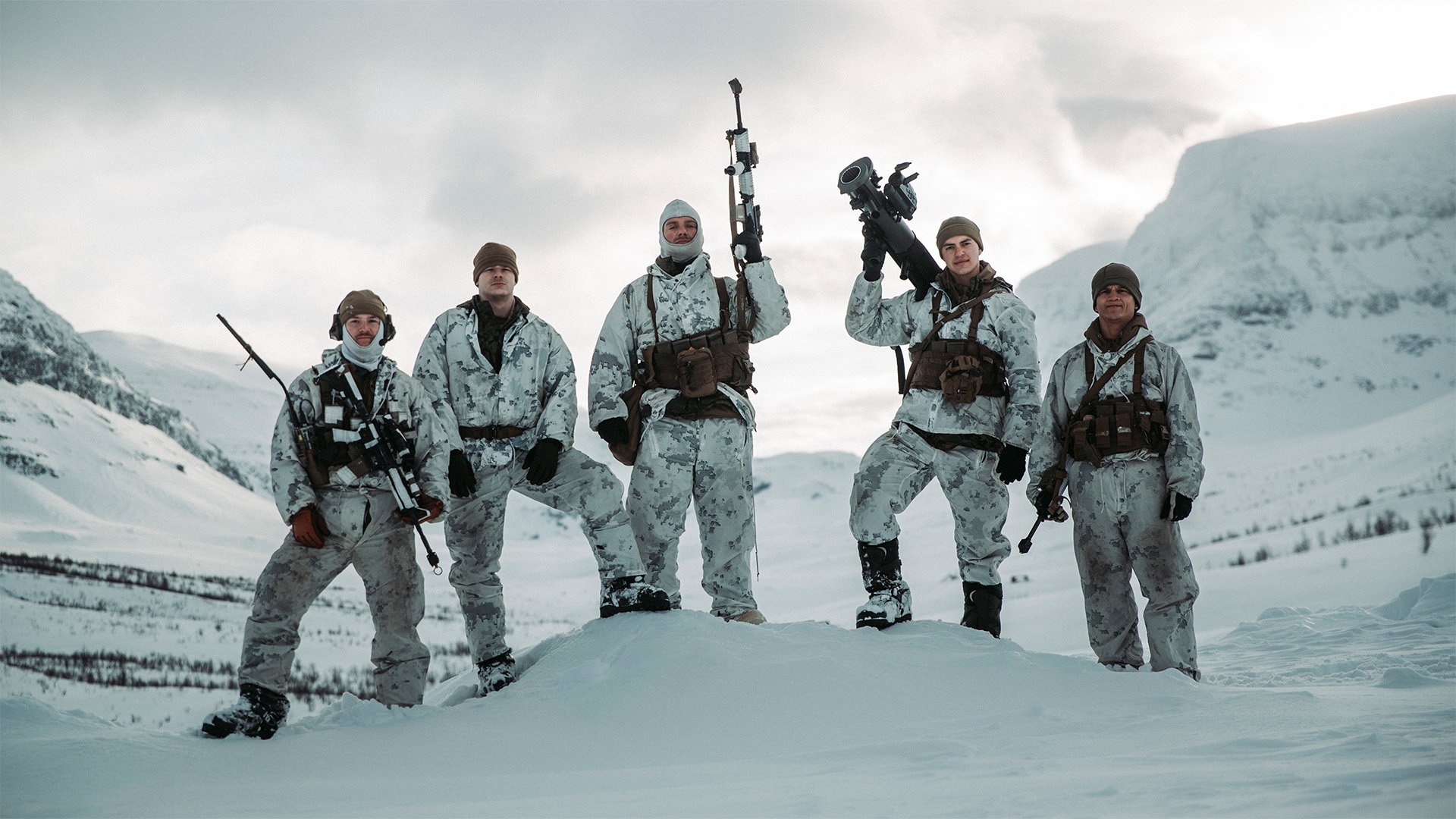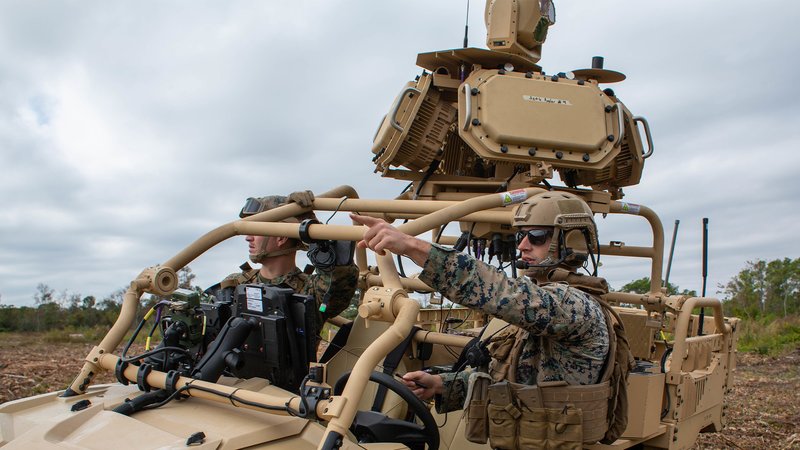
US Marines with 3rd Battalion, 6th Marine Regiment, and 2nd Low Altitude Air Defense Battalion, participate in Exercise Cold Response 2022, in Setermoen, Norway, on March 5, 2022. While grunts became the focus of counterinsurgency operations over the past two decades, LAAD Marines increasingly are valued for their growing capabilities at destroying a peer enemy's aircraft. US Marine Corps photo by Lance Cpl. Jacqueline C. Arre.
When Maj. Crispus M. Kimani commissioned into the Marine Corps a decade ago, his service was still waging twin counterinsurgency wars in Iraq and Afghanistan.
Low Altitude Air Defense officers were facing guerrilla foes with no air forces, and the Corps didn’t consider killing enemy jets, helicopters, and aerial drones its top mission.
The Corps deactivated 1st Stinger Battery in Okinawa, divested its Avenger weapons system, and stalled the Light Armored Vehicle-Air Defense Program, while dragooning LAAD Marines to become riflemen supporting US forces overseas.
“Essentially, we were doing air base ground security, security at airfields, doing patrols, just standard provisional infantry stuff tailored to OEF,” the operations officer at 3rd LAAD Battalion in California told Coffee or Die Magazine.

US Marine Corps Capt. Howard K. Mill, a low-altitude air-defense officer with 2nd Low Altitude Air Defense Battalion (LAAD), poses for a photo at Marine Corps Air Station Cherry Point, North Carolina, Nov. 9, 2022. 2nd LAAD activated an additional firing battery, increasing its number of personnel and equipment to improve the capability and lethality of their ground-based air-defense systems in accordance with Force Design 2030. US Marine Corps photo by Lance Cpl. Elias E. Pimentel III.
But the rise of Russia and China and the Pentagon's pivot toward Asia changed all that. By 2014, the Corps was scrambling to find ways to defeat increasingly cheaper and more lethal unmanned aerial systems launched not only by Moscow and Beijing, but Iran’s Revolutionary Guard.
And then in 2019, Gen. David H. Berger became the 38th commandant of the Marine Corps. But the career infantryman wasn't thinking so much about his grunts as he was those who help the rifle companies get their jobs done by controlling space and cyberspace, the sky, and the ocean.
Berger's Force Design 2030 became his call for the Corps to modernize its forces for battle against peer and near-peer foes, with an emphasis on what his blueprint called "shortfalls."
He urged the Pentagon to procure better expeditionary long-range precision fires; more medium- to long-range air defense systems; new high-endurance, long-range unmanned systems that can jam enemy communications or fire missiles at them; and a phalanx of robust short-range, point defense, anti-air systems for Kimani and other commanders to snatch the air back from future enemies.
And that’s happening quickly in Berger's Marine Corps.

US Marine Corps 1st Sgt. Rene Segura (left), battery first sergeant, and 1st Lt. Philip Holmes, the commander of Charlie Battery, 3rd Low Altitude Air Defense Battalion, Marine Air Control Group 38, unfurls the guidon during the battery activation ceremony on Camp Pendleton, California, Nov. 18, 2022. The activation of Charlie Battery increases 3rd Marine Aircraft Wing’s capabilities in ground-based air defense. Charlie Battery will be equipped with new and emerging technologies to combat unmanned aerial systems, and fixed and rotary-wing aircraft. US Marine Corps photo by Cpl. Sean Potter.
On Nov. 18, the 3rd Marine Aircraft Wing activated Charlie Battery, a signal of the Corps’ increasing investment in ground-based air defense. When it fills out, it’ll have more than 160 Marines and sailors, about the same size as a reinforced rifle company but with their eyes on the skies.
They’ll be armed with the same shoulder-fired FIM-92 Stinger homing surface-to-air missiles they have now, plus a pair of new killers: the Marine Air Defense Integrated System — called MADIS — and its less beefy cousin, the Light Marine Air Defense Integrated System, or LMADIS.
MADIS comes in two varieties — Mk. 1 and Mk. 2 — and they’re transported in Joint Light Tactical Vehicles.
Marines call the Mk. 1 their “kinetic kill” version because it fires salvos of Stinger missiles from its turret, bringing down everything from fast jets to helicopters.
Like the Mk. 1, the Mk. 2 system also has a 30mm cannon, electronic jammers, and infrared electro-optical viewers to find and pulverize targets, but the Marines call it “nonkinetic” because it's designed for downing unmanned aircraft.

US Marine Corps Pfc. Clayton Hilemon (left) and Sgt. Alexander Locconielsen (right), a low-altitude air-defense gunner with 2nd Low Altitude Air Defense Battalion (LAAD), points to a drone during a demonstration with the Light Marine Air Defense Integrated System, or LMADIS, at Marine Corps Outlying Landing Field Atlantic, North Carolina, Oct. 18, 2022. The L-MADIS is an electronic-attack system that counters unmanned-aircraft system by nonkinetic capabilities to destroy or negate aerial threats.US Marine Corps photo by Sgt. Servante R. Coba.
Similar to MADIS Mk. 2, LMADIS slays unmanned aircraft by zapping the radio frequencies connecting a drone to its controller.
But it doesn't weigh as much as MADIS, which makes it easy to load on nimble dune buggies, like the Polaris MRZRs, or ferry to the battlefield by Marine helicopters and tiltrotor aircraft.
LMADIS is being fielded by Marine units now, and its designers insist it can detect an aerial robot from a long distance and pinpoint its location to troops nearby or commanders in the rear.
And if the Marines need a little more punch, they still can unleash their shoulder-fired Stingers on the enemy.
“I have an app for that,” Kimani said. “I have LMADIS capability or a dismounted counter-UAS capability to defeat that threat.”

Then-Capt. Crispus Kimani, the executive cfficer of Marine Corps Recruiting Station Fort Worth, stands in formation with sword bearers of the Texas station's 243rd Birthday Ball celebration, Oct. 27, 2018. US Marine Corps photo by Sgt. Danielle Rodrigues.
“Right now, we're in a really good position as a community,” Kimani continued. “And we have really good problems to have in a lot of us here are pretty thankful for the opportunity to get new equipment, to get this level of visibility, to get a chance to show how our MOS and how our community will positively influence the fight of the future.
“But with all this new tech, we just can't forget that a lot of this is going to be focused on the gunner on the ground, making those decisions at a fast pace,” he said. “So I applaud the junior Marines who are getting into this community, and those who are going to be getting into it in the future, because their knowledge set is definitely going be tested. And then their capability is going to be tested. But time and time again, Marines have proven that they can integrate new technologies, and I have nothing but optimism that they'll be able to do so in the future.”
The Corps hopes to have MADIS and LMADIS in the hands of all its anti-air battalions by 2030, just in time for the next tool in the anti-air kit to arrive.

Program Executive Officer Land Systems Ground-Based Air Defense Program Manager Don Kelley shows off the expeditionary launcher of the Medium-Range Intercept Capability prototype to Marine Corps senior leaders following a successful test demonstration at White Sands Missile Range, New Mexico, on June 30, 2022. The MRIC prototype is the Marine Corps’ proposed new counter-cruise missile capability. During the test, the MRIC prototype successfully hit several simultaneously-launched cruise missile targets. US Army photo by John Hamilton.
That’s the Medium-Range Intercept Capability, or MRIC.
Similar to Israel’s Iron Dome system, MRIC uses Tamir missiles to hammer long-range cruise missiles before they reach US troops.
On June 30, 2022, the Marines successfully test-fired a prototype of the system at White Sands Missile Range in New Mexico.
To Kimani, young Marines entering the anti-air defense battalions are arriving during exciting times.

US Marines with Alpha Battery, 3rd Low Altitude Air Defense Battalion, 3rd Marine Aircraft Wing, set up M2 .50 caliber heavy machine guns at Panel Stager, Yuma, Arizona, on Oct. 6, 2019. US Marine Corps photo by Sgt. Dominic Romero.
Much like the M142 High Mobility Artillery Rocket System revolutionized field artillery and became its own military occupational specialty, MRIC could carve out a whole new career field for Marines, too.
And Kimani sees other weapons streaming into the battalions in the coming years.
They'll be systems loaded with active and passive sensors that constantly scan the skies for anything that moves, and can plug into artificial intelligence to help a Marine gunner react even faster to incoming aircraft and ballistic missiles.
“Nothing is really set in stone with this piece. We know that there are technologies out there that only can enhance the air defense capabilities of the Marine Corps,” he said.
Read Next: US: Iran Tried to Blind Warship's Bridge in Strait of Hormuz

Carl Prine is a former senior editor at Coffee or Die Magazine. He has worked at Navy Times, The San Diego Union-Tribune, and Pittsburgh Tribune-Review. He served in the Marine Corps and the Pennsylvania Army National Guard. His awards include the Joseph Galloway Award for Distinguished Reporting on the military, a first prize from Investigative Reporters & Editors, and the Combat Infantryman Badge.
BRCC and Bad Moon Print Press team up for an exclusive, limited-edition T-shirt design!
BRCC partners with Team Room Design for an exclusive T-shirt release!
Thirty Seconds Out has partnered with BRCC for an exclusive shirt design invoking the God of Winter.
Lucas O'Hara of Grizzly Forge has teamed up with BRCC for a badass, exclusive Shirt Club T-shirt design featuring his most popular knife and tiomahawk.
Coffee or Die sits down with one of the graphic designers behind Black Rifle Coffee's signature look and vibe.
Biden will award the Medal of Honor to a Vietnam War Army helicopter pilot who risked his life to save a reconnaissance team from almost certain death.
Ever wonder how much Jack Mandaville would f*ck sh*t up if he went back in time? The American Revolution didn't even see him coming.
A nearly 200-year-old West Point time capsule that at first appeared to yield little more than dust contains hidden treasure, the US Military Academy said.












